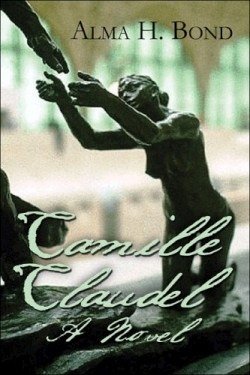Camille Claudel, a Novel
According to some critics the French sculptor Camille Claudel matched her lover the great Auguste Rodin with her artistic talents. Yet they met different fates. Rodin perished as an internationally renowned genius; Claudel died neglected in 1943 after thirty years in a mental institution.
How did such a brilliant artist fade into obscurity?
Camille Claudel: A Novel the latest book by Alma Bond addresses the mysteries of Claudel’s life art and love. Bond charts her girlhood in rural France her struggle to find tutelage and support for her art her partnership with Rodin their prolonged break-up and finally the gradual fading of Claudel’s sanity and reputation. In this fictionalized autobiography Bond takes on Claudel’s voice to justify her life to readers.
To successfully assume Claudel’s point of view Bond first lays a strong framework for her narrative in her exhaustive research including communiqués with other Claudel biographers and visits to Claudel’s frequent haunts. Thus Bond’s depictions of le Geyn the moor near Claudel’s childhood home in Villeneuve with peculiar rock formations that provided early inspiration come through as convincingly as her insights into characters’ motivations. Second as a psychoanalyst Bond applies her analytical acumen to Claudel to make this fascinating character approachable.
While Bond’s careful study and psychological background provide a solid base for the novel it is the author’s wide-angle perspective combined with her writerly skill that draws readers in instantly. Bond sees Claudel as a proto-feminist who sometimes clashed with the men in her life. At the same time these men — particularly her artistically encouraging father; her conservative but loving brother Paul; and of course the mercurial womanizing Rodin — shaped her life profoundly. It’s a testament to Bond’s skill that she transmits her conclusions about Claudel’s character convincingly in Claudel’s voice. Sometimes a modernism makes its way into the narrative (as when Claudel refers to romantic “vibes” in George Sand’s old house) but for the most part Bond ventriloquizes realistically as a reflective old French sculptor.
Bond writes with capacious sympathy for all her characters. In particular she imbues Claudel with a vibrant sensuality described in piquant detail. Here for example is the young Claudel savoring seltzer and fruit jelly with the same gusto that she tastes the rest of life: “It’s smooth except for the little lumps of fruit in it which I seize on like jewels. My tongue is covered with sweetness. I roll it to the back of my mouth until it is alive with sensation.”
Bond does falter when she shoehorns her liberated sex-positive viewpoint awkwardly into Claudel’s life but her writing shines with frequent poetic passages like the one above. Those who enjoy historical novels women’s studies or even just a compelling character study will open up Camille Claudel and will find themselves unable to put it down until the dramatic end of this striking true-to-life story.
Disclosure: This article is not an endorsement, but a review. The publisher of this book provided free copies of the book and paid a small fee to have their book reviewed by a professional reviewer. Foreword Reviews and Clarion Reviews make no guarantee that the publisher will receive a positive review. Foreword Magazine, Inc. is disclosing this in accordance with the Federal Trade Commission’s 16 CFR, Part 255.

